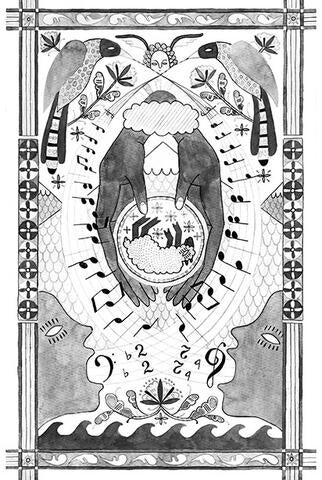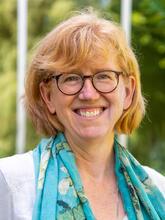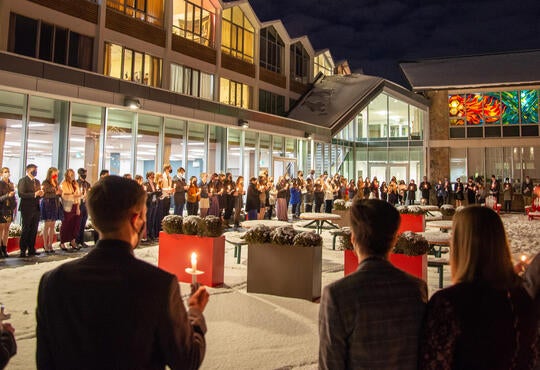One of the striking things about the new Mennonite hymnal, Voices Together, is that it includes twelve pieces of visual art.
Images reach into our lives in a different way than written text or even music. I remember sitting in church services as a little kid, paging through my Bible and looking for pictures. Children growing up in congregations with the new Voices Together hymnal will be shaped by the artwork they see week after week.
For adults too, continued repetitive exposure to a piece of art can impact us spiritually. Over time, we apprehend different things, as new layers of meaning emerge from a familiar piece of art. Christians through the centuries have known this, which is why many denominations regularly commission artwork to be placed in their worship spaces.
Sarah Johnson (BA 2007, MTS 2008, TMTC 2021) and SaeJin Lee co-chaired the hymnal’s Visual Art Committee. Johnson, Visiting Professor at Vancouver School of Theology, hopes that the hymnal will encourage congregations to “welcome the gifts of visual artists in worship leadership.” She suggested that visual art in the hymnals is “an entry for those who are less comfortable with written words and musical notation, especially children, worshipers who do not speak English, and people with different ways of learning and expressing themselves.”
“It is very unusual to include visual art in a hymnal,” Grebel Music Professor Kate Steiner remarked, noting the groundbreaking path that the hymnal committee charted. “It is used very effectively here to complement the creative work of praising God.”
The Visual Art Committee of Voices Together put out a call to artists to submit their work for consideration. The artists were invited to produce art on themes related to worship and aspects of the Christian story. The committee chose a dozen pieces to represent the diversity of the church in terms of gender, racial/ethnic identity and geographic location.
One of the artists was Meghan Harder (BA 2013), who lives in St. Catharines, Ontario. As a visual artist, she observed, “Growing up, the arts in Mennonite culture was typically very music focused, so it was really exciting to have an opportunity to participate in the cultural life of Mennonites in a way that was more natural to me.”
Harder submitted a sample of her art, and the committee asked her to create something on the theme of “praising,” giving her specific biblical texts on which to reflect. She was drawn to the Book of Psalms for her inspiration and included images from the poetry of the Psalms in her piece.
The artists used a variety of media: drawing, painting, printmaking, papercut, photography and digital illustration. One of the challenges for the artists was knowing their work would be reproduced in black and white and grey, and would be reduced to the size of a hymnal page.
 “Sing the Goodness” by Meg Harder uses imagery from the Psalms, including human mouths, waters that roar, and mountains that sing together.
“Sing the Goodness” by Meg Harder uses imagery from the Psalms, including human mouths, waters that roar, and mountains that sing together.
Harder often creates fraktur, a style of art which comes from the Pennsylvania Dutch tradition. While her fraktur work is often characterized by bright colours, for this piece she deliberately used an ink wash. “Grayscale brought a sobriety or sombreness to the work that I had not been able to achieve before. I really liked the effect.”
Artist SaeJin Lee talked about the feedback she received from the committee in the artistic process. They encouraged her to create a work of art that would appeal to children. There was “enthusiastic affirmation for keeping the depiction of people with various abilities represented in the final image,” Lee said. “The woman in the wheelchair was part of my initial sketch as well. To include that, I think, celebrates many people from different backgrounds, including those with various abilities in our midst.”
Until mid-August, the Grebel Gallery will exhibit art from the hymnal, and some companion pieces by the same artists. The exhibit is called “Voices Together: A Celebration of Art and Music.”
The exhibit was curated by Rachel Epp Buller, Professor of Visual Arts and Design at Bethel College and the Director of the Regier Art Gallery, where it was first shown. Buller is also one of the twelve featured artists. She curated a gallery book for this exhibit, which is available online, at the link below.
Paul Heidebrecht, Director of the Kindred Credit Union Centre for Peace Advancement at Grebel, explained the usefulness of this gallery book as a resource. “Each artist provides details on their contribution, and Magdalene Redekop (Professor Emeritus, University of Toronto) shares about her experience viewing the original pieces of art alongside their reproductions in the hymnal. For those who can’t make it to the gallery,” he added, “this online resource is a great way for people to see the artwork in the original colours.”
After being shown at Bethel College, the exhibit then moved to Eastern Mennonite University. Jerry Holsopple, EMU Professor in Visual and Communication Arts, reflected on the exhibit. In addition to seeing the works in their original sizes, the exhibit “allows you to view them on their own without the temptation to explore the texts that accompany them.”
Using visual art in worship is natural for some congregations because they regularly draw on the art of their own church members in worship, whether through featuring it physically in the sanctuary, reproducing it in a bulletin, or projecting it during a Sunday service. Other congregations may be unsure about how to use visual art. There are excellent resources in Voices Together: Worship Leader Edition on how artwork can be used in worship.
 Carol Penner teaches and writes in the area of practical theology. Her research interests include feminist theology, Mennonite peace theology, and abuse issues. She shares her own worship resources at www.leadinginworship.com.
Carol Penner teaches and writes in the area of practical theology. Her research interests include feminist theology, Mennonite peace theology, and abuse issues. She shares her own worship resources at www.leadinginworship.com.
The Visual Art Committee carefully chose the song or hymn that would appear beside the artwork in the hymnal, as well as a scripture passage on the reverse page. Worshipers can be encouraged to look at a work of art while scripture is read. For churches that have purchased a projection version of the hymnal, the images can be projected on a screen for the whole church to see.
Another option is a guided meditation called Visio Divina, in which worshipers encounter God through the sense of sight. The worship leader encourages people to enter the artwork reflectively, meditatively, and prayerfully. This practice is based on the belief that God can speak to us through art, as it is a “visual retelling of God’s story.”
In Redekop’s essay in the gallery book, she commented on Anne Hostetler Berry’s piece “Alive.” She described how the familiar peace dove is defamiliarized. With bold black lines, the dove is drawn into a vortex in the center of the cross. The hymn on the facing page is “Low in the Grave He Lay.”
Mennonites have not always been comfortable with visual art in worship. Grebel Professor Emeritus Tom Yoder Neufeld, who was also part of the Voices Together Visual Art Committee, explained: “While uneasiness about visual art goes back millennia in Christian traditions, including Anabaptism, we have come to value deeply the capacity of visual art to deepen our spiritual sensitivity, our worship, and our relationship to God.”
Heidebrecht thinks that the presence of the artwork in the hymnal, and the experience many will have as they view the original artworks in a gallery, may significantly impact our worship practices. “We are eager to see how people’s experience of the original artwork that is reproduced in the Voices Together hymnal will prompt reflection—and provide inspiration for—the role of the visual arts in worship.”
The exhibit at the Grebel Gallery runs until August 19. For gallery hours, or to book a group tour, contact the gallery.
Plan your visit: uwaterloo.ca/centre-peace-advancement/grebel-gallery






